
Kitagawa Utamaro was a Japanese artist. He is one of the most highly regarded designers of ukiyo-e woodblock prints and paintings, and is best known for his bijin ōkubi-e "large-headed pictures of beautiful women" of the 1790s. He also produced nature studies, particularly illustrated books of insects.
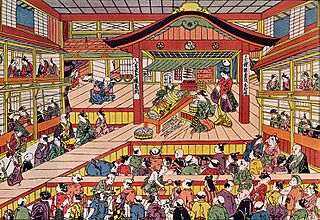
Ukiyo-e is a genre of Japanese art that flourished from the 17th through 19th centuries. Its artists produced woodblock prints and paintings of such subjects as female beauties; kabuki actors and sumo wrestlers; scenes from history and folk tales; travel scenes and landscapes; flora and fauna; and erotica. The term ukiyo-e translates as 'picture[s] of the floating world'.
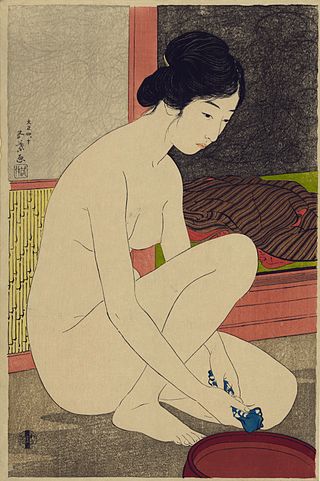
Shin-hanga was an art movement in early 20th-century Japan, during the Taishō and Shōwa periods, that revitalized the traditional ukiyo-e art rooted in the Edo and Meiji periods. It maintained the traditional ukiyo-e collaborative system where the artist, carver, printer, and publisher engaged in division of labor, as opposed to the parallel sōsaku-hanga movement.
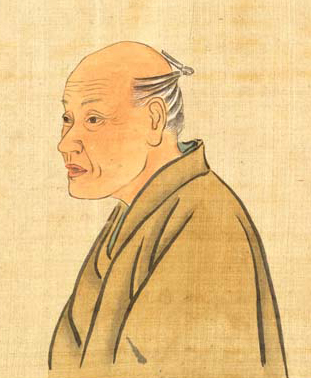
Ōta Nanpo was the most oft-used pen name of Ōta Tan, a late Edo-period Japanese poet and fiction writer. Ōta Nanpo wrote primarily in the comedic forms of kyōshi, derived from comic Chinese verse, and kyōka, derived from waka poetry. Ōta Nanpo's pennames also include Yomo no Akara (四方赤良), Yomo Sanjin, Kyōkaen, and Shokusanjin (蜀山人).
The New Otani Art Museum was an art museum founded in 1991 and housed on the sixth floor of the Hotel New Otani Tokyo's Garden Court office building. The Hotel, located in Tokyo's Chiyoda Ward, opened in 1964 to coincide with the Tokyo Olympic Games.

The Yamatane Museum of Art is a museum in Japan specializing in the nihonga style of Japanese watercolour painting. It is run by the Yamatane art foundation.
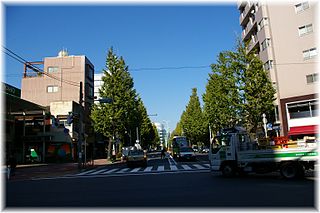
Shirokanedai (白金台) is a district of Minato, Tokyo. The district today is made up of 5 chome. As of November 1, 2007, the population of Shirokanedai is 10,001.

The Setagaya Art Museum is an art museum in Yōga, Setagaya, Tokyo. The museum, which opened March 30, 1986, houses a permanent gallery and mounts seasonal exhibitions.

Kamata (蒲田) is a district of Ōta, Tokyo, Japan. Features include the Kamata Station, Kamata High School, and the headquarters of Toyoko Inn.

The Japan Folk Crafts Museum is a museum in Komaba, Meguro, Tokyo, Japan, dedicated to the hand-crafted art of ordinary people (mingei). Access is from Komaba-Tōdaimae Station of Keio Inokashira Line.

Ishikawa Toyonobu was a Japanese ukiyo-e print artist. He is sometimes said to have been the same person as Nishimura Shigenobu, a contemporary ukiyo-e artist and student of Nishimura Shigenaga about whom very little is known.
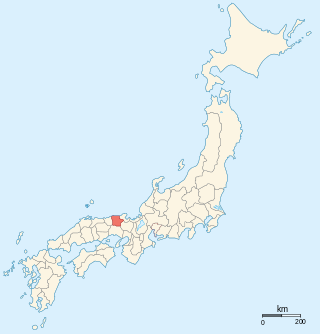
Utagawa Toyoharu was a Japanese artist in the ukiyo-e genre, known as the founder of the Utagawa school and for his uki-e pictures that incorporated Western-style geometrical perspective to create a sense of depth.
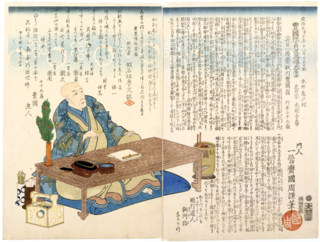
Shini-e, also called "death pictures" or "death portraits", are Japanese woodblock prints, particularly those done in the ukiyo-e style popular through the Edo period (1603–1867) and into the beginnings of the 20th century.
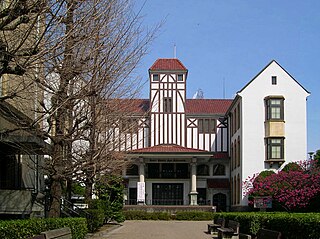
The Tsubouchi Memorial Theatre Museum of Waseda University is a university museum devoted to the history of drama, with facilities used for cultural performances from all over the world. The museum was named for Tsubouchi Shōyō, a famous writer known for his work with theater and translation of the collected works of Shakespeare into Japanese. It is commonly known as Enpaku in Japanese.

Koishikawa Ukiyo-e Art Museum is located in Bunkyō, Tokyo, Japan. Its collection includes ukiyo-e genre paintings from the Edo period, in particular, prints by Utamaro, Hokusai and Hiroshige. Every month the museum changes the ukiyo-e exhibition. This small museum was opened in November 1998. Its aim is to promote understanding of ukiyo-e culture.
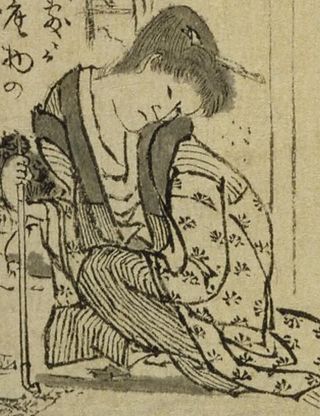
Katsushika Ōi, also known as Ei (栄) or Ei-jo, was a Japanese Ukiyo-e artist of the early 19th century Edo period. She was a daughter of Hokusai from his second wife. Ōi was an accomplished painter who also worked as a production assistant to her father.

Chōbunsai Eishi was a Japanese ukiyo-e artist. His last name was Hosoda (細田). His first name was Tokitomi (時富). His common name was Taminosuke (民之丞) and later Yasaburo (弥三郎). Pupil of Kano Eisen'in Michinobu. Born as the first son of direct vassal of the Shogunate, a well-off samurai family that was part of the Fujiwara clan. Eishi was a vassal of the Shogunate with a generous stipend of 500 'koku' of rice. Eishi left his employ with the Shōgun Ieharu to pursue art. His early works were prints, mostly Bijin-ga portraits of tall, thin, graceful beauties in the original style established by himself akin to Kiyonaga and Utamaro. He established his own school and was a rival to Utamaro. He was a prolific painter, and from 1801 gave up print designing to devote himself to painting.

Kabukidō Enkyō was a Japanese artist who designed ukiyo-e woodblock prints. Nothing is known of Enkyō's life, and only seven of his works are known, all of which are ōkubi yakusha-e, bust portrait prints of kabuki actors. Scholars divide them into two groups based on differences in the signatures, and the second group appears to be a set, as the prints depict three brothers from the same play. Enkyō's identity has been subject to speculation: a student of Sharaku's, even Sharaku himself, or a kyōgen playwright.

Ota City General Gymnasium is an arena in Ōta, Tokyo, Japan. It is the home arena of the Earth Friends Tokyo Z of the B.League, Japan's professional basketball league.


















